
All bloggers have a number of websites that they visit every single day. Aside from the obvious ones (like email and Twitter), your favorites might be anything from your blog’s publishing calendar, to your online to-do list, to all your favorite social media button generators.
Wouldn’t it be great if all of those helpful resources were just a click away? 
That’s exactly what bookmarks are for. In your web browser, bookmarks are links to specific websites that show up as buttons at the top of your web browser — making it easy to visit your favorite websites.
How to bookmark websites will depend on the browser you’re using. But trust me, it’s easy. Here are links to instructions for how to add a bookmark for four popular web browsers:
Chrome
Safari
Firefox
Internet Explorer
Now, let’s get bookmarking. What are some of the best websites that all bloggers should add to their bookmark bar? Check out 30 of the HubSpot blogging team’s favorites below. (And be sure to share your own favorites in the comment section.)
30 Websites Every Blogger Should Bookmark
For Keeping Organized
1) Publishing Calendar
Figuring out when you should publish which blog posts is time-consuming enough, right? Bookmark your publishing calendar so it’s only a click away at any given time. You can use it to keep your topics and authors organized, track keyword and call-to-action usage, and make sure all your blog posts are written on time.
If you’re a HubSpot customer, you can bookmark your HubSpot Calendar App.
If you’re not a HubSpot customer, then you can create a publishing calendar using Google Calendar and bookmark that.
(Are you also responsible for running your company’s social media accounts? Then you might want to bookmark social media publishing calendar tools as well.)
2) Trello
Trello is a really simple collaboration platform you can use to brainstorm and organize your blog post and project ideas. Bookmark it so you can easily add new blog post ideas as you think of them, manage your own post-writing to-do list, and see what the rest of your team is working on. You can also use it to build an editorial and social media publishing calendar, prioritize different tasks, and organize notes.
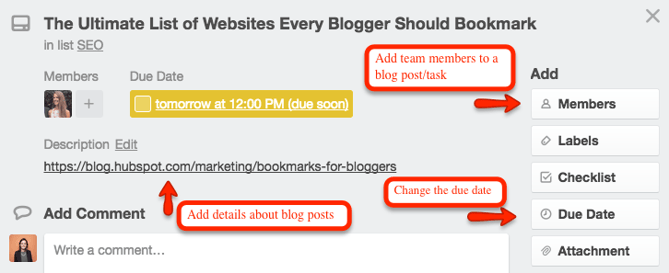
3) Evernote
While you can install Evernote as an app on your computer and any device, you may also want to make the website a bookmark on your web browser. Even more specifically, you can make notes within your Evernote into separate bookmarks: one for your to-do list, one where you store useful snippets of HTML, one where you store inspiring articles or ebooks, and so on.

4) Waterfall Graphs
We use waterfall graphs to keep track of daily progress on our traffic and leads goals on the blog. If you’re a HubSpot customer, your marketing software has a built-in waterfall chart template that will generate these graphs for you — so you might want to bookmark that page in HubSpot. If you’re not a HubSpot customer, you can create a waterfall graph yourself in Google Spreadsheets and bookmark that.
For Data Analysis
5) Percent Change Calculator
I can’t even begin to tell you how useful this little calculator is when looking for and analyzing data. Ever want to know the percentage change of two values without having to remember the formula? Simply enter the two values into this calculator, and it’ll spit out the percentage change.
6) Atlas (by Quartz)
Atlas is Quartz’s slickly-designed command center for all its charts. There are all kinds of cool, useful data in there — everything from Prada’s share price over time to the highest CEO-to-worker pay ratios in the U.S. You can download, embed, or grab the data. It’s open source so you can create your own versions, too. One of the best ways to build credibility on your blog is to back up your claims with data and evidence, so bookmark resources like Atlas so you can easily search for and grab the data and charts you’re looking for.
7) Comprehensive List of Marketing Statistics
Whether you’re a blogger who writes about about marketing, or you just need statistics to back up your strategy in a team presentation, it’s tricky to find the original source of data within the rabbit hole of the internet. We’ve put together a massive list of marketing statistics that are up-to-date and categorized for easy reference.
For Blog Ideation
8) Quora
Quora’s question-and-answer platform features questions from real people in your audience — and what better way to appeal to your readers than by answering their questions? Quora also offers an upvoting feature that lets you see how many other users are interested in the answer to a question, which can help you prioritize your response blog posts.

9) Portent’s Content Idea Generator
When you drop a topic into this neat little tool’s search bar, it proposes eye-catching, humorous title and topic ideas for you to test out. It also provides reasoning for the proposed titles, and you can make it spit out a new title idea if you’re unsatisfied. It might not produce the perfect title for your blog post, but it will get your creative juices flowing if you’re wondering what format or style in which to write.
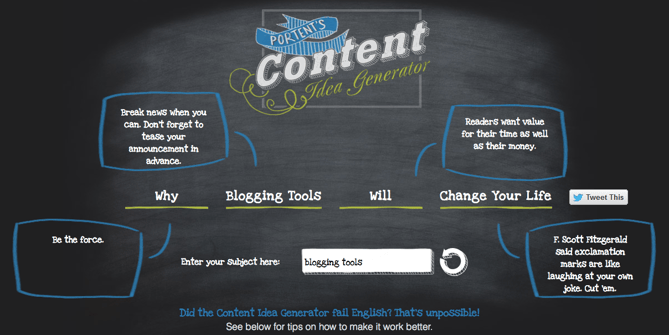
10) HubSpot’s Blog Topic Generator
Our handy free tool produces a week’s worth of blog post title ideas when you submit three nouns or keywords you’re trying to write about. The tool is particularly helpful because you can generate ideas about specific angles by entering several search terms at once. I submitted “blogging,” “tools,” and “marketing,” and I got back these five interesting title proposals:
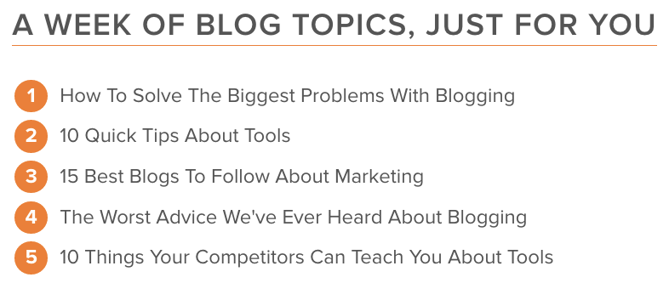
For Writing
11) Style Guide
When you’re blogging, posting on social media, and creating other types of marketing content regularly, it’s important to have a written style guide to ensure your writing style is consistent across different marketing channels. But it can take a long time to learn all the nuances of your brand’s style guide, so have it bookmarked for easy reference while you’re writing and editing. (And if you don’t have a style guide yet, learn how to create one here.)
12) Keyword Tools
Keyword research comes in handy when you’re brainstorming, writing, editing, and creating headlines for your blog posts. That said, keep your favorite keyword tool bookmarked. Here are a few of our favorites:
HubSpot’s Keyword Tool (30-day trial)
Google AdWords’ Keyword Planner
Google Trends
Want to learn more about how to do keyword research for SEO? Check out this blog post.
13) WordCounter
Although there’s no “right answer” for how long a blog post should be, sometimes word count can come in handy. Bookmark WordCounter so you can quickly paste in your content to see how many words you’ve written.
14) Dictation.io
Let’s face it — if you’re a full-time blogger, you might get exhausted by writing sometimes. Don’t worry though, it happens to us too. When you need to take a break, try Dictation.io, a dictation tool that translates talk to text. This is a great way to keep the tone of your blog post conversational and to switch things up if you’re getting writer’s block.
For Editing
15) Pre-Publish Checklist
It can be pretty hard to remember every little thing you should check on a blog post before hitting “Publish.” That’s why we bookmarked this pre-publish checklist, which is a complete list of everything you should do when editing and proofreading your blog content. It covers everything from ensuring all your sources are properly attributed to double checking all your links work.
16) Hemingway App
Have you ever been in the middle of writing a blog post and realized your writing felt a little … convoluted? Bookmark the free Hemingway App for moments like these. All you have to do is paste your content into it, and it’ll assess your writing and identify opportunities to make it simpler. For example, it’ll point out instances of passive voice and hard-to-read sentences.
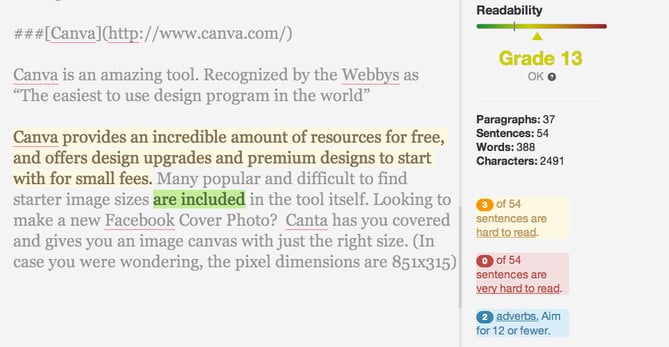
17) Tone Analyzer
In the same vein as analyzing readability, what about analyzing tone? Sometimes, you might be reading over a blog post and feel like it comes off as a little too negative or a little too excited. Tone Analyzer is a free tool that uses linguistic analysis to detect the tone of a piece — and then offers helpful tips on how to improve and strengthen the tone.
18) HTML Elements
If you edit a lot of blog posts, chances are you’ll be working with HTML on a regular basis. I like to keep this list of HTML elements handy so I can easily make changes to HTML when needed. From there, I can use CTRL + F to jump right to the HTML element I’m looking for.
19) HTML Score
Speaking of HTML, here’s another great HTML resource to bookmark. It’s a long list of special characters that HTML 4.0 processors should support, like the copyright symbol ©, currency symbols € ¥ ¢, and so on.

Image Credit: HTML Score
20) HTML Cleaner
Source codes can sometimes seem to take on a personality of their own and pull in crazy HTML snippets — especially if you’re copying and pasting from an external file, like Google Docs. If you find yourself having that problem regularly, bookmark a tool like HTML Cleaner so you can quickly remove any superfluous code from your content.
21) & 22) Grammarly & Correctica
Before you can officially say you’re done editing a blog post, you should run it through an editing tool like Grammarly or Correctica to triple-check there are no grammatical errors. (Bonus: Grammarly even checks for plagiarism.)
23) Headline Analyzer
You’ve written and edited your blog post. At this point, the only thing standing between your cursor and the “Publish” button is an eye-catching headline. Once you have a few ideas in mind, head to your bookmark bar and open up the Headline Analyzer, a free tool that scores your headline quality and rates its ability to drive social shares, traffic, and SEO value. It also shows you how it will appear in search results.
24) StockSnap.io
Once you’ve written your blog post, a great header image captures reader attention on social media. There are numerous stock photo websites featuring free photo downloads that you’re free to distribute, and we like StockSnap.io’s trending feature that shows you popular photo downloads — so you can steer clear of them to make your blog posts more unique than other web content.
25) Compressor.io
A photo compressor can help speed up the time it takes to load your web page and make your photos smaller for easy social media sharing. Drop your stock photo of choice into Compressor.io, and it will generate a new, compressed image for you to download and use in your blog post.
For Social Media
26) ClickToTweet
Creating a tweetable link is a lot easier than learning custom code. Bookmark ClickToTweet so you can create basic tweetable links to accompany cool quotes in your blog posts at a moment’s notice. (Learn how it works here.)
27) Pinterest’s “Pin It” Button Generator
Ever seen those “Pin it” buttons that let you pin an image to your Pinterest board? We use Pinterest’s “Pin it” button widget builder all the time to create those buttons for images we post on our blog. Bookmark that page so you can create and place these buttons next to images, infographics, and other visual content on your blog. (And scroll to the bottom of this blog post for instructions on how to build your own.)
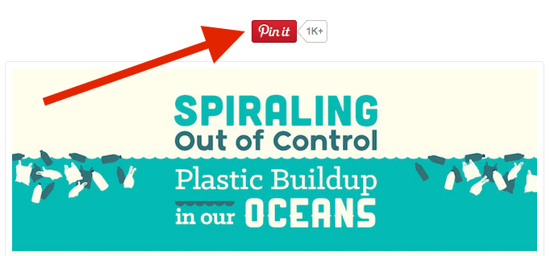
28) Social Media Button Cheat Sheet
While we recommend bookmarking some of your favorite social media button widget builders (like the “Pin it” button builder above), you may want to go ahead and bookmark this cheat sheet as a handy reference. It has links to all the widget builders for share and follow buttons for Twitter, Facebook, LinkedIn, Pinterest, and Google+. It also includes step-by-step instructions for how to create them and implement them on your website and blog.
29) BuzzSumo
BuzzSumo shares analytics about how many social media shares a URL has received, so when you’re getting ready to publish blog posts on social media, drop links into BuzzSumo to see which types of content perform the best. You can also glean insights about posts from your competitors or previous posts from your blog to see which are most shareable and clickable. Here’s an analysis of one of our blog posts about Facebook ads:

30) Embed Code Generator
Do you create original pieces of visual content (like infographics) and post them on your blog or website? Then you’ll want to provide embed codes alongside them so it’s easy for your readers to share them on their own blogs. (Plus, it’ll help you generate some inbound links because the embedded image will automatically link back to your website.) Bookmark the embed code generator so you can easily create these HTML snippets. (And read this post for instructions on how to use it.)
Here’s an example of what an embed code looks like (taken from this blog post):
Share This Image on Your Site <p><strong>Please include attribution to Blog.HubSpot.com with this graphic.</strong><br /><br /><a href=’http://blog.hubspot.com/marketing/productivity-diet’><img src=’http://cdn2.hubspot.net/hub/53/hubfs/00-Blog-Related_Images/The_Productivity_Diet-_What_to_Eat_to_Get_More_Done_in_the_Day_FINAL.jpg?t=1434740339844&width=669′ alt=’the productivity diet’ width=’540px’ border=’0′ /></a></p>
What are your favorite websites to bookmark that help you be a more efficient blogger? Share them with us in the comments.
Editor’s Note: This post was originally published in September 2015 and has been updated for freshness, accuracy, and comprehensiveness.


![]()

